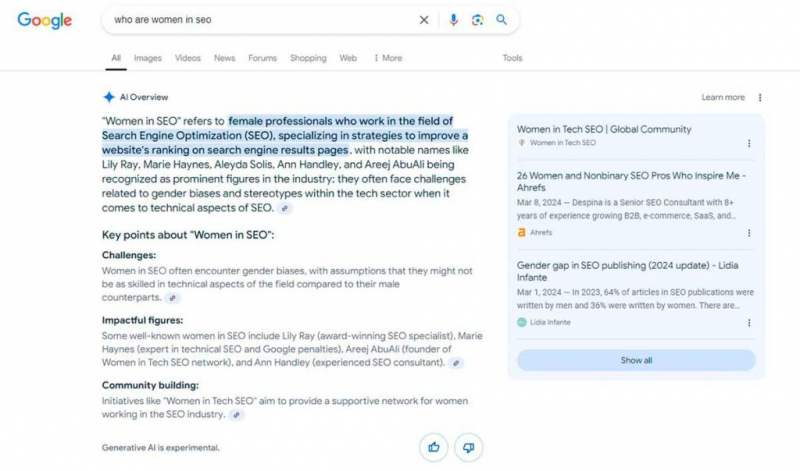BrightEdge corporate SEO service shared the results of the analysis of millions of search queries, identifying 6 key trends in Google organic search related to the rollout of November 2024 Core Update.
The data obtained allows us to conclude where the search engine algorithm will move in late 2024 and early 2025, and what is important for webmasters and SEO specialists to know.
The main trend – AI Overviews (reviews from AI) – is a relatively new search function representing answers from generative AI. Any changes to Google’s main ranking algorithm will be reflected in the AIO, especially because there are several ways that AIO and organic search results intersect.

Recommendation of the month: Telega.in — a platform for native integrations in Telegram channels. Manually verified channels and bots. We help you find your target audience in Telegram and launch effective integrations.
- 1. The intersection between Google organic search and AI reviews
- 2. Customer requests (shopping) are ranked differently
- 3. The tendency to decrease the intersection of AI and search
- 4. The overall increase in search results volatility due to Google November 2024 Core Update
- 5. Specific changes in individual niches
- 6. Patterns in quoting AIO content
- Conclusions from search volatility
- Overview of specific examples in the context of Google November 2024 Core Update
- Are there any reasons for optimism after the Google November 2024 Core Update?
1. The intersection between Google organic search and AI reviews
One of the most interesting trends in November is the intersection between sites in AI reviews and in classic search results. These changes, first noticed by SEO specialists in September, showed themselves especially vividly in the top 10 organics.
The higher the content is ranked in a regular search, the higher the chance that it will be cited by AI. Google tries to actively link reviews from AI with its main ranking algorithm.
Exactly how Google reconciles SERP with AIO is anyone’s guess, since Google has not commented on this trend in any way. Perhaps AIO relies on organic search results that best match the subject of the search query.
Google’s patent “Contextual estimation of link information gain” closely links Google’s organic search ranking with an artificial intelligence-based search interface. And BrightEdge here notes a certain symmetry between AI search and organic responses.

2. Customer requests (shopping) are ranked differently
The tendency for organic and AIO SERP to intersect is not evident in purchase-related requests. Here, the classic search and answers from AI are increasingly diverging in different directions.
BrightEdge concludes that for shopping, Google’s AI learns from additional data arrays (unlike, for example, information queries), which is why the results so often do not coincide with organic search.

3. The tendency to decrease the intersection of AI and search
In early November, there was a slight increase in volatility (+2.3%) between the organic and AIO rankings, but then there was a downward trend (-3.7%), which continued after the announcement of the rollout of the update.
4. Overall increase in search results volatility due to Google November 2024 Core Update
After the release of Google November 2024 Core Update, the volatility between organic search results and AIO began to grow seriously. BrightEdge interprets these changes as evidence that there is a redistribution of output.
However, this may reflect changes in both AIO and organic ranking, which should stabilize at some point. As always, it happened when rolling out algorithm updates.

It is worth noting that the scale of changes at lower ranking levels (positions 21-30) indicates a high level of volatility.
Google SERP dynamics since the update was announced:
- top 10: +10.6% volatility;
- top 11-20: -5.9% volatility;
- top 21-30: +23.3% volatility.
Keep this in mind if you regularly remove positions, for example, in Topvisor. The changes you see in the tool may have nothing to do with your activity.
5. Specific changes in individual niches
BrightEdge analyzes specific industries, and at the moment there are significant changes in requests related to e-commerce and education.
Important changes by niche:
- E-commerce: -22.1% of changes in the top.
- Education: -7.3%.
- Medicine: -1.5%.
- B2B technologies: -0.4%.
It should be emphasized that the data of the BrightEdge generative parser displays changes in real time in millions of search results (which indicates the scale of the changes).
6. Patterns in quoting AIO content
The revealed patterns give a preliminary idea of which queries Google prefers in this update. However, keep in mind that these are real-time results that may change as new parts of the update are implemented.
BrightEdge comments on volatility indicators:
- educational content remains stable;
- product-oriented content demonstrates higher volatility;
- sites research-oriented, demonstrate sustainability;
- industry expertise is becoming more visible.
Conclusions from search volatility
BrightEdge offers its interpretation of the assessment of the current volatility of Google organic search, in terms of the potential citation of your content in AI reviews:
- Prioritize value for users when creating
